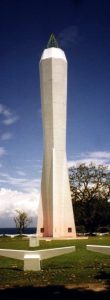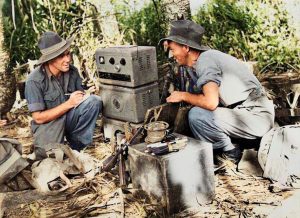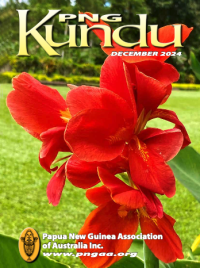MEMORIAL NEWS
2025—50th Anniversary of PNG Independence: How will Australia Acknowledge This?
Not many Australians would have a good understanding of Australia’s history in PNG. This is because this history is not taught in schools. Many Australians know of Kokoda, but they know little of the Australian history in PNG before and after this historical event. When Australia had territories in PNG, textbook authors such as Edgar Ford included information about PNG in their educational publications. The late Edgar Ford, who was the first school captain of Dubbo High School, was a lecturer at the Australian School of Pacific Administration.
As Sean Dorney has said in his book, The Embarrassed Colonist (2016), Australia needs to reconnect with PNG.
Including Australia’s role in the creation of PNG as an independent country in the school curricula throughout Australia would be a more significant investment in the long run. As Sean has said:
Whilst there were some things from the colonist era that we should not celebrate, helping give birth to another nation should have been one of our proudest achievements.
PNG has used rugby league as part its school curricula to unite the country. Likewise, to improve Australia’s relationship with PNG, Australia needs to include the teaching of PNG in its school curricula. Otherwise, our relationship with PNG will remain wanting.
Patrick Bourke
Editor’s Note: The Rabaul & Montevideo Maru World War II New Guinea Islands Education Program is available online through the Rabaul and Montevideo Maru website – https://montevideo-maru.org/education/
Did You Know?
The Myrtleford Times on 18 September 2024 had an article focussing on local Bright resident Roger Turner’s search for the MS Montevideo Maru. The article was titled ‘Captain Turner’s deep sea search’. Roger was the Search Director on the Fugro Equator when the Silentworld Foundation found Montevideo Maru in April 2023. The continued interest helps to keep the story alive. Please let us know of any media articles.
Feel Like a Trivia Champion?
One of the contestant’s on ABC’s Hard Quiz on 2 October 2024 had Midnight Oil as his specialist subject. The last question was ‘What was the name of the ship on which Peter Garrett’s grandfather died in WWII?’ Let us know if you include trivia questions about this history in your community activities!
Coastwatchers Memorial
The last two World War II coastwatchers, Jim Burrowes (101) and Ron ‘Dixie’ Lee (100) passed away in Melbourne in July, Jim on 7 July and Dixie on 8 July 2024. A tribute to them was in the September 2024 PNG Kundu.
Vice Admiral Peter Jones (Retd) wrote:
The courageous deeds of the legendary and secretive WWII coast watchers represent one of the most illustrious chapters in Australia’s military history.
Prior to World War II, the Royal Australian Navy detailed a former New Guinea District Officer, Lieutenant Commander Eric Feldt, to establish a network of expatriates who could covertly report on enemy movements around the coastline of New Guinea and the Solomons in time of war. In short order, he recruited planters, patrol officers and even priests for this potentially dangerous assignment.
When the Japanese invaded the islands in 1942, these coast watchers undertook their mission with courage and at great personal cost. Some were beheaded, others simply disappeared, while others continued their clandestine task for months on end with the help of local villagers.
As the value of the coast watcher network became fully appreciated, servicemen from the three services joined for this most dangerous of assignments. Signalman Burrowes and Able Seaman Coder Lee were among a cohort of radio operators who provided that crucial communications link using the cumbersome AWA Teleradio, portable with the help of local men who also risked their lives.’
The Coastwatchers communicated by radio through existing radio stations or by teleradios. They were given some instruction and a code with which to make their reports on any hostile movements and to report any item of intelligence value. It was a lonely and precarious existence.
After the capture, torture and murder of Percy Good in early March 1942, an elderly copra planter on Buka Island, off Bougainville, all civilians were enlisted into the RAN in the belief that their combatant status would protect them if they were captured by the enemy. Percy Good had been executed by the Japanese at Kessa plantation, Buka, following an indiscreet Australian news broadcast which mentioned a Japanese convoy that had been sighted off Carola Haven near Kessa several days earlier. This event caused the military authorities to formally appoint all existing, and future, civilian Coastwatchers to naval rank.
In 1942 when General MacArthur assumed supreme command of the South-West Pacific Area it was decided that the Coastwatchers should become part of the Allied Intelligence Bureau under the direct command of General Headquarters (GHQ). By then there were over a hundred teleradios all linked to their own centre, either Port Moresby, Rabaul, Tulagi or Vila.
The Coastwatchers were supported by all three services. Aircraft dropped their supplies and submarines and PT boats landed them and removed them. The assistance and loyalty of the local population was essential: they performed a vital role in guerrilla operations and intelligence gathering.
On 5 August 1959 the Coastwatchers Memorial Lighthouse at Madang was Unveiled
Roma Bates, wife of Charles D Bates, MC, a Coastwatcher on New Britain who at the time of his death in 1954 was District Commissioner, Madang, wrote two letters following the event, a composite of which were published in Una Voce, September 1999. Due to space, we include excerpts here, however, please refer to the original article, available to members on the PNGAA website, which provides a unique description of this memorable and special occasion.
One thing that shines through is the camaraderie between the Europeans and Papua New Guineans who worked together in the jungle (the word native was not ‘politically incorrect’ until some years later).
Madang will never again have a weekend as wonderful as the one just past. A weekend of pomp and solemn ceremony, of homage and remembrance to those no longer with us, of joyous reunion and festivity. The atmosphere was overwhelming, and one was caught up in it and swept along with the tide. For months and months we have watched the progress of this Lighthouse with great interest, admiring its graceful white line which gives the impression of swirling upwards to the light itself, and on Saturday we saw the culmination in the impressive unveiling ceremony which commenced at 5 pm.
Every effort had been made by the Navy and Air Force to bring Coastwatchers, widows and relatives from every part of Australia and New Guinea to be present at this ceremony – never again, in the history of New Guinea, will there be so many of them gathered together. It was [Eric Feldt’s] book, The Coastwatchers, come to life—with a few sad omissions.
Saturday, Elma Good arrived (direct from Kessa—the Governor-General had lent his plane for the RAAF to fly widows and relatives from all over to Madang for the ceremony).
I wish I could convey to you the excitement and feeling in the air. They were gathered there en-masse and everyone made a great fuss over everyone else. The atmosphere was terrific and it was so heart-warming and wonderful. ‘… by afternoon all the enclosures were packed, every tree dripped with spectators’.
 The Memorial is, without question, the most beautiful and magnificent design to commemorate the work these men did. As they watched the coast, so now does their memorial. The design was surely inspired. Its simple classic lines sweep from a four-finned base to a fuller top surmounted by a bronze guard in the shape of a flame (narrow strips of bronze which outline the shape of a candle flame) and within this guard swings a 1,000,000 candlepower searchlight.
The Memorial is, without question, the most beautiful and magnificent design to commemorate the work these men did. As they watched the coast, so now does their memorial. The design was surely inspired. Its simple classic lines sweep from a four-finned base to a fuller top surmounted by a bronze guard in the shape of a flame (narrow strips of bronze which outline the shape of a candle flame) and within this guard swings a 1,000,000 candlepower searchlight.
The construction is of dazzling white cement. The lighthouse, 90 feet high, stands on a base of red terrazzo tiles, and on this circle, between each set of fins, is a bronze plaque. The plaque between the two front fins is the Honour Plaque with the names of the fallen, on the left side is a plaque which reads:
In honour and grateful memory of the Coastwatchers and of the loyal natives who assisted them in their heroic service behind enemy lines during the Second World War in providing intelligence vital to the conduct of Allied operations. Not only did they transmit by means of teleradio from their jungle hideouts information which led to the sinking of numerous enemy warships, but they were able to give timely warning of impending enemy air attacks. The contribution towards the Allied victory in the Pacific by the small body of men who constituted the Coastwatchers was out of all proportion to their numbers.
The space between the fins at the back has no plaque as it serves as the entrance to the ladder that goes up inside the light. The remaining space is occupied by a plaque containing the above inscription in Pidgin English for the benefit of the native community.
The Light standing on its red circle is set in the centre of a huge cross, the wide arms of which serve as footpaths; this in turn, is surrounded by a large enclosure of crushed coral fenced with 3 foot high pyramids of white cement suitably spaced and connected with black chains. The Light is situated on the Point at the entrance to Madang Harbour – where the old light used to be.

Two of the coastwatchers with the New Guinea Air Warning Wireless Company at work beside their AWA radio at an observation post
Originally, the design was supposed to represent a torch, similar to a Legacy torch, but it was necessary to add the four fins at the base for strength and to carry the weight, so that now, it looks like a finned bomb with the warhead sliced off. A truly magnificent sight, with the revolving searchlight taking the place of the bomb warhead.
The ceremony commenced with the posting of three sentries at the base of the Light – a member of the Volunteer Rifles (Bruce Collins), a rating from the Swan and the Air Force was the third. This was followed by Guards of Honour of European and Native Naval ratings, New Guinea Volunteer Rifles and Royal Papua and New Guinea Constabulary taking up position.
It was touching to see the warm welcome and comradeship extended to the Native Coastwatchers by their European counterparts as they arrived one by one to take up their places in the enclosure.
Everyone gathered around the Light to read the plaques and on all sides friends were greeting friends they had not previously caught up with, particularly so between Native and European. Faces lit with joy at seeing each other again. Here, for the first time, I saw exemplified what we are striving for throughout Papua and New Guinea—the mutual respect, admiration and real affection between European and Native. It filled me with hope for the future and showed that, even without the benefit of higher education, the Native and European can go forward together with mutual confidence. The happiness of comrade greeting comrade was wonderful to see and their joy was mine also when the Native Coastwatchers, unsolicited and unprompted, found me in the dusk. Shaking my hand warmly and long, they spoke glowingly and feelingly of your father and we were all very emotional.
Another Coastwatcher who was made a great fuss of was Yawita. He lost his eyesight and an arm. He was flown immediately to Brisbane and Elizabeth [Sowerby] was the theatre sister when he was brought to Greenslopes. He was completely blind. But a fortunate (for him) accident happened in Brisbane just at the right moment—a man was killed in a car accident. His body was rushed immediately to Greenslopes, his eye was removed and a corneal graft was done on Yawita. Now, 14 years later, he can still see. It is wonderful don’t you think? It was the first corneal graft ever done in Queensland, if not in Australia. It was lovely to see the reception Yawita got when he arrived to take his place with the Coastwatchers. Although he has sight in one eye, he cannot see with perfect vision. He arrived with his artificial arm, an eye-shade over the blank eye, and the blue eye (blue eyes on a native look so startlingly out of place) looking around questioningly; all this coupled with his flowing beard made him an outstanding figure. The Europeans, as one man, left their seats and flocked round him shaking him by the hand and all talking at once. It was a terrific vignette. All the Native Coastwatchers received warm welcomes as they arrived, one by one.
The names of many of the coastwatchers who died are recorded on the memorial at Madang:
‘Watched and Warned and Died that We Might Live’.
More information can be found HERE


